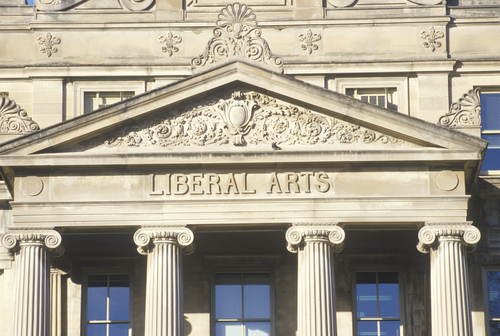What Do You Do With Liberal Art Humanities and Communication Major

When you lot're comparing colleges as a prospective student, consider what kind of schoolhouse is right for you and what kind of instruction y'all want. Liberal arts colleges provide students with a broad didactics that combines numerous subjects of study in the arts, natural and social sciences, and humanities for the purpose of learning how to call up and communicate. Rather than preparing students for a single career path, a liberal arts education equips students with the skills and knowledge they need to be better learners, thinkers, and global citizens.
A Liberal Arts Curriculum
At a liberal arts college, you volition written report a variety of subjects in the arts, humanities, and natural and social sciences. Students in liberal arts colleges may study several of the artistic arts. Courses in fine art, music, theatre, and artistic writing are common. The humanities refer to subjects that study the human being condition and culture. In liberal arts programs, students often take humanities courses such as history, classical or modern foreign languages, philosophy, English literature, and theology. Social sciences, too, hold an important place in a liberal arts curriculum. Expect to study subjects similar sociology, geography, anthropology, political science, and economics during your liberal arts didactics.
Y'all might non be able to tell by the proper name, but mathematics and science are crucial subjects of study in a well-rounded liberal arts education. Courses similar biology, physics, and chemistry are common in a liberal arts curriculum. Students typically have to have a minimum of 1 college-level math grade during their bookish careers, with options ranging from statistics to algebra, trigonometry, and calculus.
The Jobs of Tomorrow
Most people have a moment when they're young where they think, When I grow up, I'm going to be a ____ and they fill up in the blank with whatsoever career appeals to them at that moment. While it's prissy to dream about the jobs we might hold tomorrow, the truth is most people don't really know what the jobs of tomorrow will exist. According to Southwestern University, this statement isn't hyperbole. Around 65% of students today will be in jobs in the future that don't exist today. Fifty-fifty more unsettling is the fact that forty% of the jobs that currently exist won't be in the future. They'll go obsolete.
It begs the question, then, how are students expected to fix for this eventuality? Won't this reality make college degrees useless? No, that isn't the case. The people who are best suited for these jobs are those who studied the liberal arts.
Here'south why. A liberal arts education teaches students how to think and to solve issues. Think about it this way. One plus one ever equals two. Unfortunately, bug fill the world that don't fit into dandy mathematical equations. More one correct respond to a problem often exists. Some problems also require more than than ane solution in order for them to be solved effectively. Those who know how to use their creative muscles usually solve those problems.
…It's engineering science married with liberal arts, married with humanities, that yields us the results that make our heart sing. – Steve Jobs
It isn't that Stem career fields don't have their identify in the globe. They definitely practise. Withal, as fifty-fifty many in the STEM fields have begun to notice, the bug that cause bug in the Stem world are homo problems. Technology past itself won't solve those problems. Someone with an understanding of both STEM and the humanities has a better shot at it.
It stands to reason, then, that the jobs of the future will be held past people who know how to solve problems, perchance even bug that the modern workplace hasn't experienced still. The liberal arts students of today accept put themselves in the position of being the workplace problem-solvers of tomorrow. They become the people working in the jobs of tomorrow.
Education Across the Disciplines
A liberal arts education equals an education that spans the disciplines. Many universities require their students to complete a certain number of classes in subjects that aren't related to a pupil'south major. Schools oftentimes call these clusters of classes core or foundational classes. These include classes in literature, arts, sciences, mathematics and social sciences. These courses provide students with a foundational noesis of the world and its history.
These classes introduce students to subjects they may not see otherwise. Sometimes, these courses even influence a pupil's decision when information technology comes fourth dimension to pick a major. A form that introduces students to the written report of fine art, biological science, or field archeology may get the stepping rock to a whole career down the route. Given that many students enter college with no item major in listen, it really is possible for a seemingly random grade to change a student's whole career outlook. Often that'southward how people encounter their dream careers: by accident.
Aside from this, these classes help students understand how one discipline affects another. For example, in a foundational geology course, students may learn that in 1815, a volcano erupted in Indonesia. According to Forbes, the effects of the 1815 volcano were such that information technology changed the weather around the world, including in Europe in 1816. That year likewise happened to be the year that Mary Shelley wrote "Frankenstein." Shelley's volume was partly influenced past the dark and stormy weather that the volcanic eruption acquired. In fact, people chosen 1816 "the year without summertime" considering the volcanic ash caused terrible weather.
Growing crops was impossible in 1816. People starved. They moved beyond the European landscape in search of food, much the way the creature in "Frankenstein" did. His appearance is said to exist inspired by those climate refugees. Out of this destruction came one of the almost dear pieces of literature the world has ever known.
A liberal arts instruction exposes students to facts similar this. Information technology allows them to see how seemingly unrelated events affect the globe. This exposure gives ascension to newer, broader ways of thinking. Every bit "Frankenstein" proves, a situation that occurs halfway around the world from someone tin accept profound furnishings on localities one-half a earth away. The written report of liberal arts teaches students virtually these events. It also forces them to examine how they might deal with such an event, which broadens their creative thinking and problem-solving skills.

A Component of STEAM
Many people who work in technology have begun to sympathize that non everyone wants a career in a Stalk field (scientific discipline, technology, technology, or math). Withal, that doesn't hateful that liberal arts majors and STEM majors need to exist at cross-purposes with each other. On the contrary, each subject has something to offer its counterpart.
The addition of the "A" and the "R" to Stalk brings both the arts and reading and writing into the STEM curriculum. Truth be told, many students in the liberal arts use technology every mean solar day to exercise their work. On the flip side, those who embrace STEM fields run across the shortfall that only concentrating on STEM causes.
Very often, STEM problems aren't due to technical issues per se. Instead, they arise because humans run engineering. They meet ethical bug. They realize that the digital divide keeps some people from accessing technology in a way that is meaningful. STEM training alone doesn't solve these issues. Knowledge of the human condition and ethics frequently does. For case, a educatee who studied philosophy may get on to have a career in wellness administration or law, co-ordinate to the University of Maryland because these career fields crave people to have an understanding of ethics and the humanities.
That being said, a person who has studied philosophy, i of the many liberal arts majors available to students, is in a unique position to move into a tech career. This is due in part to the fact that this particular liberal arts degree requires students to report logic. It besides taps into how the brain works and how people think. That being said, modern estimator scientists often try to replicate how the homo brain thinks, something that liberal arts majors must call up nigh a lot. This puts many liberal arts majors (and non just philosophy majors) in the running for some very cool, very lucrative careers.
Career Options for Liberal Arts Majors
Many people mistakenly believe that a liberal arts education is the easy manner to a degree. Nothing could be further from the truth. A liberal arts education requires students to adhere to rigorous standards of enquiry, to develop trouble-solving skills, and to expend a large dose of commitment in society to reach their educational goals.
A liberal education besides prepares students for a number of careers that may not seem to be related on the surface. However, due to the broad nature of these types of degrees and due to the transferable skills they teach students, a liberal arts degree can actually translate into very lucrative job options.
 Some liberal arts students parlay their ability to write, a skill they honed during their college days, to go writers. Many plough to careers in journalism or public relations. Others combine their honey of technical subjects and writing to become technical writers. Depending on the chore they do and the number of years of experience they bring to the table, these former liberal arts majors earn betwixt $61,000 and $lxx,000 a year.
Some liberal arts students parlay their ability to write, a skill they honed during their college days, to go writers. Many plough to careers in journalism or public relations. Others combine their honey of technical subjects and writing to become technical writers. Depending on the chore they do and the number of years of experience they bring to the table, these former liberal arts majors earn betwixt $61,000 and $lxx,000 a year.
Others turn their dearest of promotion into a lucrative career in the field of marketing. Possible jobs include marketing director, SEO author, advertising designer, or art managing director. These professionals earn betwixt $100,000 and $131,000 per year, according to Maryville Academy.
The field of didactics also proves to be a popular pick among liberal arts graduates. Typically, these graduates choose a major, similar art or biological science, and then they tack on classes in education. If these students earn a bachelor's degree, they become elementary or high school teachers. If they earn advanced degrees, like a master's or doctorate, they qualify for teaching positions at the university level.
Given how much liberal arts students must read and write during the grade of their studies, it'south no wonder that many of them get excellent researchers in the process. This skill qualifies them to become enquiry analysts. Big companies hire researchers when they need to make decisions about rolling out new products services or if they want to motility into new markets. Research analysts make well-nigh $lxxx,000 a year on average.
 Translators and interpreters usually come up to the ranks of former liberal arts majors. People who major in world languages put themselves in a position to translate documents, books, Tv shows, and movies or to interpret proceedings at conferences, business meetings, and in court. U.S. News & World Report name translation and estimation equally the #1 jobs on the news site's All-time Creative and Media Jobs list.
Translators and interpreters usually come up to the ranks of former liberal arts majors. People who major in world languages put themselves in a position to translate documents, books, Tv shows, and movies or to interpret proceedings at conferences, business meetings, and in court. U.S. News & World Report name translation and estimation equally the #1 jobs on the news site's All-time Creative and Media Jobs list.
People who speak Castilian, Chinese, German, Portuguese, and Russian have especially lucrative futures ahead of them. Demand for those who have these skills is expected to increment past most 20% through the year 2028. On average, translators and interpreters brand virtually $fifty,000 per twelvemonth, though the best paid amidst them make $67,000 a twelvemonth and above.
An Teaching for the Sake of Learning
At a liberal arts college, the main goal is teaching itself, more and then than job preparation, according to The Hechinger Report. Instead of focusing mainly on learning specific technical skills that tin can become outdated very quickly cheers to changes in technology and the economy, a liberal arts education teaches students to recall, learn, and communicate. That doesn't hateful a liberal arts education is useless for getting a job. A liberal arts curriculum includes enough of reading, critical thinking, and work involving written and speech communication. This makes for keen preparation for graduate schoolhouse in subjects such as business, technology, law, and even medicine.
The didactics path as well allows students a chance to cultivate versatile skills that employers in all fields prize, like teamwork, communication, and analytical skills, CBS News reported. Liberal arts students become good at thinking critically, seeing the big moving picture, working with a team, and communicating well. Between these skills and their solid educational background in many subjects, liberal arts students accept a strong foundation that allows them to fit into a broad variety of careers.
A liberal arts didactics is a keen option for students who dearest to learn and want to develop abilities that make them improve students, more insightful employees, and more enlightened citizens.
Related Resources:
twenty Affordable Principal's in Journalism Online Programs
Top 30 Most Affordable Master'southward in Reading Online Programs
Top 10 Highest Paying Jobs For Liberal Arts Majors
desailllymindighisent.blogspot.com
Source: https://www.bestcollegesonline.org/faq/what-does-a-liberal-arts-education-teach-you/